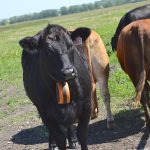Stewardship program needed | If American growers fail to use the correct blend of seeds, tolerance would be lost
The experts in charge of protecting the midge tolerant trait in Canadian-made wheat varieties are keeping an eye on the United States, where no such varieties are available.
Todd Hyra, western Canadian business manager for SeCan, said nine midge resistant wheat varieties are available to commercial growers in Canada, including seven Canada Western Red Spring (CWRS) varieties, one Canada Prairie Spring (CPS) variety and one Canada Western Extra Strong (CWES) variety.
Other midge tolerant varieties are also in the commercial pipeline, and Canada’s first amber durum line containing the midge-resistant Sm1 gene was supported for registration at the Prairie Grain Development Committee meetings in Saskatoon last week.
Read Also

Why feds imposed EV tariffs
Moe and Kinew have a fight on their hands when it comes to eliminating the EV tariff. Canada has to worry about pissing off the U.S. and Mexico and hundreds of thousands of auto workers.
North American farmers grow millions of acres of durum on both sides of the border.
Estimates vary, but it is believed that midge-tolerant wheat blends save Canadian producers as much as $50 per acre. The number is likely higher for durum production.
Hyra told a meeting of midge tolerant experts in Saskatoon last week that there is no evidence midge-tolerant wheat varieties are being grown in the U.S.
However, he said U.S. growers are aware of the technology.
Canadian experts in charge of maintaining the technology would like to have an American stewardship plan in place before Canadian midge tolerant varieties begin showing up in the U.S.
“Over the last four years, we’ve developed a team and a stewardship plan for Canada, but in the U.S. that doesn’t exist,” Hyra said.
“We need to ensure that before any (seed) goes into the U.S., that there is a solid plan in place that ensures the technology is maintained on both sides of the border.”
Damage caused by the orange blossom wheat midge does not stop at the Canada-U.S. border, he added.
“I think it all boils down to the fact that we’re dealing with a pest that can overcome the tolerance very quickly if there is not a refuge (variety) in place,” Hyra said.
“If tolerance happened to be lost in the U.S., it would only be a short time before it was lost in Canada as well due to wind movement of the insect.”
Midge tolerant wheat varieties derive their tolerance from a single gene known as Sm1.
Scientists at Agriculture Canada isolated the gene more than a decade ago, and western Canadian farmers grew the first midge tolerant wheat varieties commercially in 2010.
The Sm1 gene causes wheat plants to increase production of a naturally occurring organic acid when midge feed on them.
Higher acid levels in the kernels cause the midge larvae to stop feeding, eventually resulting in starvation.
Basing midge tolerance on a single gene is a precarious strategy.
To preserve the efficacy of the Sm1 gene, a Canadian midge stewardship team employed a strategy known as an interspersed refuge system.
Wheat seeds that contain the Sm1 gene are sold as part of a varietal blend that contains roughly 90 percent midge tolerant seeds and 10 percent midge susceptible seeds.
The refuge system disrupts the insect’s ability to produce resistant offspring, thereby prolonging the midge-tolerant technology.
One of the keys to maintaining the effectiveness of an interspersed refuge system is to ensure that refuge or susceptible varieties contained in the varietal blends are maintained within an acceptable range.
In Canada, experts involved in developing and commercializing Sm1 wheat drafted a stewardship agreement that must be signed by all farmers who buy the seed. The agreement requires farmers to limit the use of farm-saved seed to one generation past certified.
Stewardship provisions also allow for random and targeted farm audits.
A database has been established to monitor sales of certified midge tolerant seed in Western Canada and automatically flags irregularities in seed buying patterns. Farmers who are flagged will be contacted by mail or phone.
Hyra said monitoring and enforcement are an important part of protecting the technology and educating producers.
Almost 600 farmers in Western Canada will be contacted by the midge stewardship team beginning this month.
Producers who plant farm saved seed for more one generation and others suspected of selling midge tolerant seed may be subject to fines or other disciplinary action.
Midge tolerant wheat continues to enjoy rapid adoption by producers.
One-third of the wheat acres planted in Saskatchewan each year are planted with midge tolerant varieties, Hyra said.















